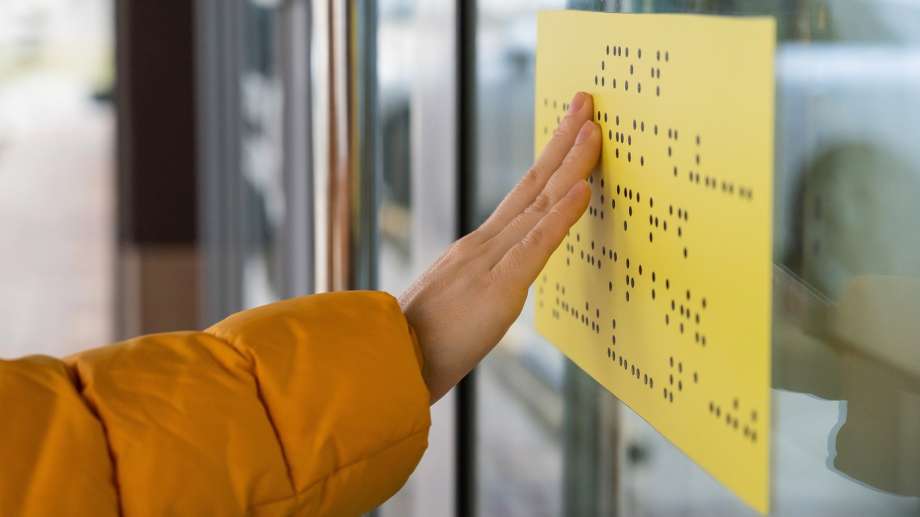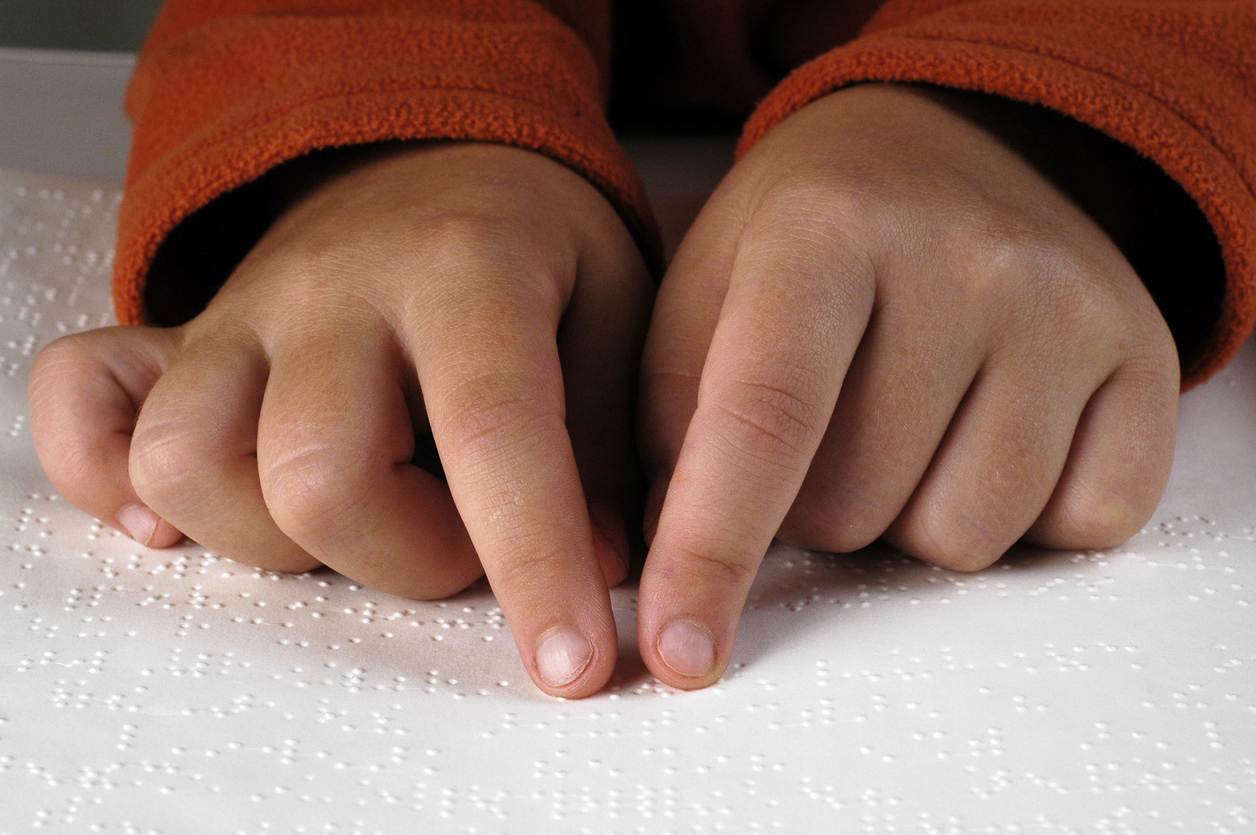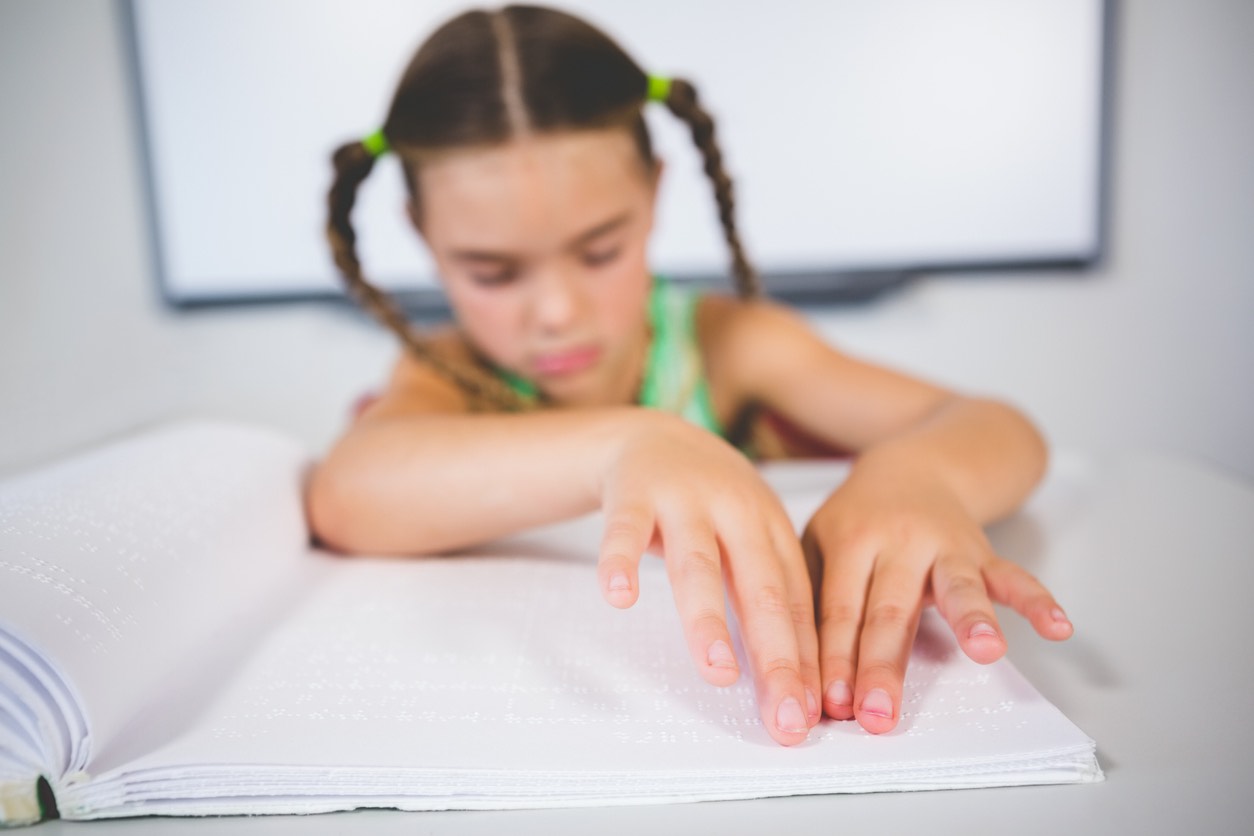Teach Your Little One How to Read Braille With 7 Easy Steps

Children with visual impairments rely on their other senses like smell, touch, and taste to learn about the world around them. In the past, children with visual impairments had no way of reading or writing. Today, thanks to Louis Braille, many blind children can use braille to read and write.
There are many statistics about visual impairments that bring to light the benefits of learning braille. Here are just a few:
- According to the National Braille Press, 70 percent of working-age blind people are unemployed and instead depend on disability benefits.
- According to the National Federation of the Blind, learning braille increases a blind person’s chance of succeeding in secondary school and finding work.
- According to the Indiana Blind Children’s Foundation, children with visual impairments should begin learning braille literacy at a young age because they need to be literate and be able to communicate with others who are visually impaired. Parents should start with fun braille activities when their children are young.
If you are interested in teaching your toddler how to read braille, keep reading.
The Components of Braille
Braille is a tactile writing and reading system for the visually impaired. According to BrailleWorks, it is a code; it is not a language. The alphabet, numbers, and punctuation marks are represented as raised dots, and the characters are read by feeling them with their fingertips.
According to Science Direct, braille was created by a Frenchman named Louis Braille, who was blinded in childhood. He was frustrated that there was no way for the blind to read and write; therefore, he decided to create his own system, which became known after his death.
Braille symbols are made from braille cells. A braille cell is made of six dots arranged in two columns. The dots in the cells are combined in many ways to create various symbols, including the letters of the alphabet, words, and numbers.
According to the Perkins School for the Blind, each braille dot has a number. The dot in the top left corner of the cell is 1. Dot 2 is under dot 1, and dot 3 is under dot 2. Dot 4 is located in the upper-right corner. Dot 5 is under dot 4, and dot 6 is under dot 5.
Uncontracted vs Contracted Braille

There are two main forms of braille. Uncontracted braille is a form of braille that involves writing out each number, punctuation, and letter in a word. According to the American Foundation for the Blind, children can learn uncontracted braille before kindergarten. They are introduced to the second form of braille after kindergarten.
However, because uncontracted braille tends to be very lengthy, many adults use contracted braille. This form of braille is complicated and is always taught after uncontracted braille is learned. It combines cells to make shortcuts for words and phrases. A single braille letter can represent an entire word.
When is a Child Ready to Learn Early Braille Literacy?
Blind children should begin learning braille at the age of 3, according to the Professional Development and Research Institute on Blindness.
To teach their children early braille skills, parents should collaborate with their children's educational team. Some schools have a specialized teacher known as a Teacher of Students with Visual Impairments (TVI) – this teacher specializes in visual disabilities and can provide advice and resources to parents to help their children.
Parents should learn braille too to help their children become braille readers. Parents should also encourage their children to complete braille activities to help them master the skills.
How to Prepare Your Child to Read Braille
Before your child can read and write braille, they must strengthen a few skills. You can help prepare your child to read braille by
- Surrounding your child with braille. You should make sure that your house has braille everywhere. You can label anything your child comes into contact with. The American Printing House (APH) provides braille labels.
- Helping to strengthen your child’s fine motor skills. Perkins School for the Blind provides many online activities to help blind children master fine motor skills.
- Investing in tactile books. Tactile books help build children’s vocabulary by creating a connection between the feeling of an object and its name.
- Scribbling with your child. Before sighted children learn how to write, they engage in scribbling. This is an essential step in learning early literacy. Blind children should also be encouraged to scribble on a braille writer.
Before teaching your child braille, you need a few tools. Some tools you will need include something that resembles a braille cell, a braille writer, braille books, tactile books, and a BrailleBuzz, which is an educational tool.
According to the National Federation of the Blind, parents should give a child a slate and stylus to learn to write braille. Cardstock paper is put into the slate, and a stylus is a tool used to punch holes in the paper. The holes form the braille dots. A slate and a stylus are just like paper and a pencil. They should experiment with them even if they do not know how to create anything meaningful.
7 Steps for Teaching Your Little One How to Read Braille

Just like sighted children go through a learning process to acquire literacy skills, your child must go through a learning process to be able to read braille. Braille reading skills are mastered with practice, consistency, and a positive attitude. Usually, uncontracted braille is taught to beginners. You can teach any young learner to read braille by following the below steps.
1. Introduce Braille Books
Even though toddlers aged 2-3 are too young to read, introducing them to braille books is a great way to get them familiar with the tactileness of braille by running their fingers over the words in the book. Try narrating the words as they move their fingers. According to the Reading Agency, reading books helps blind people to connect to the real world and gives them a sense of how the world around them looks.
The American Action Fund for Blind Children and Adults provides a free braille book each month for blind children. Through the Braille Books Program, blind children can talk to others about the books they discover.
2. Teach Them how to Use Their Fingers and Hands
Fingers are important in reading braille. Children need to know which fingers to use and how much pressure is needed. You should teach your child to
- Relax their hands and fingers completely when reading braille. You can gradually teach your child how to do this through a series of fun activities, for example, peel a banana and ask your little one to gently run their fingers across it without getting them sticky.
- Use the two techniques: hand-over-hand and hand-under-hand. Put your hands over their hands and help them learn how to move their hands to read braille, and let them put their hands over yours to feel how you do it.
- Locate the top left corner of the book and the first row of braille, by using the above techniques. Your child must relax their entire hand and use all their fingertips (except their thumb) to feel the letters from left to right. Once the row is done, they should keep their left hand on the first row and find the next row with their right hand.
- Avoid scrubbing. According to the American Foundation for the Blind, slow braille readers, as well as young children, tend to reread characters by placing their fingertips on the same character over and over. This is called scrubbing, and you should encourage your child to avoid this behavior.
3. Learn Braille Yourself
According to Family Connect, it’s important for parents to learn braille so that they can bond with their children and help them with the learning process. It’s also important for the parent to actively read braille in front of their child.
4. Slowly Introduce the Braille Alphabet
After learning how to control their fingertips, beginners should learn the braille alphabet. Learning braille is a developmental process that takes time. Young learners should first begin with reading letters, then transition into reading simple words.
According to the National Federation of the Blind, you should teach your child the first ten letters of the alphabet. They are the basis of the entire braille code. There are many fun activities you can do with your child to teach them the braille alphabet, for example, you could
- Sing the alphabet song while your child touches each braille letter.
- Sequence alphabet cards from A to Z.
You can take things slowly by giving them one letter per week. The American Printing House (APH) provides many activities that children with visual disabilities can complete to learn the alphabet.
5. Use the Braille Writer
Before teaching braille, your child should already know what a braille writer is. After learning to read the alphabet, he or she should try to write it using the braille writer. You could write them first and let them read whatever you write. Toddlers are not going to perfect their reading and writing. Do not look for perfection. Reading and writing braille should be fun.
6. Begin Reading Words
You should write simple words in uncontracted braille for your child to try to read. Learning to read braille will be simple for them if they know the braille letters and their sounds.
Some simple words you can start with include “can,” “do,“ “you,” “it,” “but,” “have,” and “good.” Once they get used to reading simple words, they can start with more complex words and simple sentences like “You can do it.”
7. Make it Fun
As we all know, toddlers learn best through play. Playing teaches them about the world around them and helps develop their imagination. Here are some activities you can do with your child to teach them how to read braille
- Paths to Literacy created a braille rap song. Let your child hold up the correct alphabet card while listening to the rap song.
- Introduce your child to the alphabet basket. For each letter of the week, add a braille block and a tactile object beginning with the letter to the basket. Let your child feel and explore the basket. Teach them the sound of each letter.
- Make braille letter cards. Draw the six dotted braille cells. You will need 26 copies of it; one for each letter. Glue buttons on each braille cell and create different configurations to represent each letter of the alphabet.
- Create touch-and-feel cards. Use a pipe cleaner to make the shape of a number or letter and glue it to a piece of cardboard. Let your child feel it so that they can imagine how sighted children see numbers and letters.
Many of the above instructions may seem very complex for a three-year-old. Don’t be overwhelmed by this – your child does not need to master all of these techniques at such a young age. Simply start introducing them to these skills, activities, and techniques so they can gain familiarity with braille.

